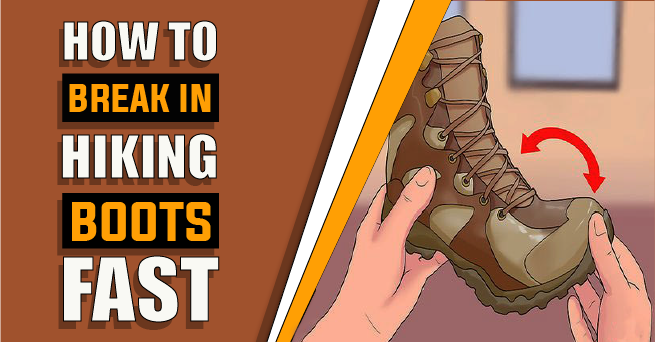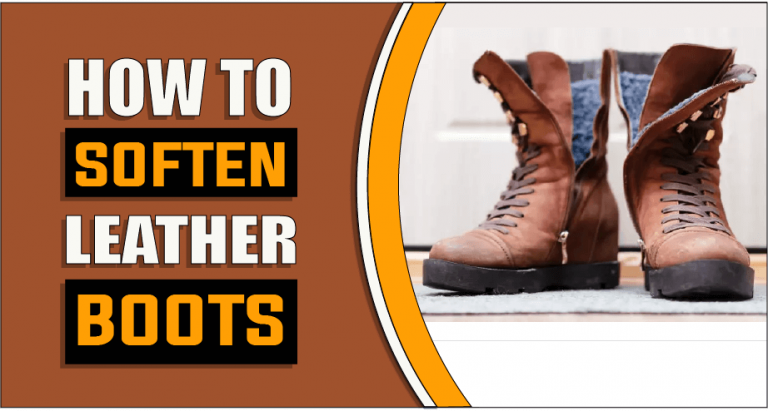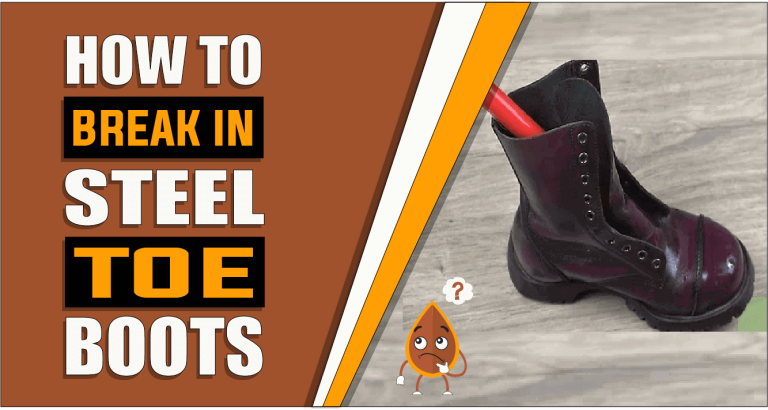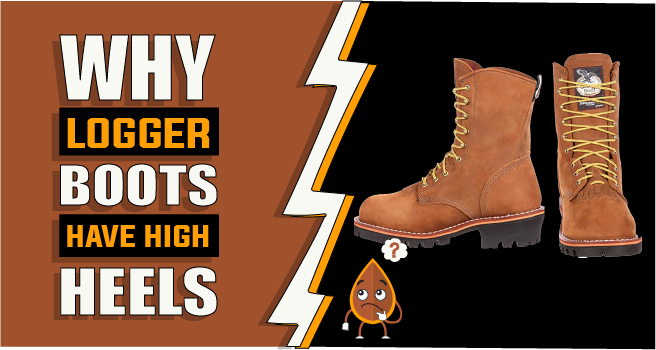How to Break in Hiking Boots Fast – 10 Effective Ways
As someone who enjoys hiking, you should understand the importance of having the correct equipment. Where a solid pair of hiking boots is one of the most critical pieces in a hiker’s equipment. But if you’ve never had a chance to break them in before your big hike, don’t worry—there are a few ways to speed up the process. This blog post will walk you through ten methods for how to break in hiking boots fast. So whether you have a tight deadline or just want to get it out of the way so you can start enjoying your new boots, follow these tips, and you’ll be good to go!

How to break in hiking boots fast – 10 effective ways
Hiking boots are a must-have item for any hiker who enjoys spending time outside. Whether you’re an experienced hiker or a beginner, a good pair of hiking boots can make all the difference on the trail. However, breaking in brand-new hiking boots can be a little difficult. At first, they might feel pretty stiff and painful, and you may even get blisters.
But don’t panic; there are several things you can do to swiftly and effectively break in your hiking boots. This article will share ten tips for breaking into your hiking boots fast.
1. Wear Them Around the House
One of the best ways to get your hiking boots ready for the trail is to wear them around the house. This will help to soften up the leather and fabric, and it will also give you a chance to get used to the feel of the boots. Try your best to wear them every day for at least an hour or two. This will speed up their breaking-in process. It’s fine if you can’t wear them for extended periods. Just wearing them for a little while each day will still help.
2. Walk Around the Block
Paved surfaces are another excellent method for breaking in your hiking boots. These can be anything from sidewalks to parking lots. Walking on pavement will help to soften up the leather and fabric, and it will also help mold the boot to your foot. If you can, try to walk for at least 30 minutes each day. This will help them settle in faster. If you can’t walk for that long, that’s okay. Just walking for a little while each day will still help.
3. Wear Them While Hiking:
Of course, the ideal method to break in your hiking boots is to go hiking in them. Start by going on short, simple hikes. This will help you get used to the feel of your boots and allow them to slowly mold to your feet. Similarly, pay attention to how your feet feel and make sure to stop if you start to feel any kind of pain or discomfort.
4. Use a Boot Horn:
If you find it challenging to get your feet into your hiking boots, using a boot horn can be a big help. A boot horn is a tool that helps slide your feet into the shoes more easily. It is typically available in most places where hiking equipment or boots are sold. It can be quite beneficial when breaking in new boots. If you have trouble getting your foot into the boot, you’re likely to have even more problems when you’re out on the trail.
5. Use a Boot Stretcher
If your hiking boots are tight, you may want to invest in a boot stretcher. This is a tool that you can use to help stretch out the fabric and leather of your boots. Simply insert the boot stretcher into your boot and twist it until you feel the boot start to stretch. For best results, you can leave the boot stretcher overnight. If you’re having difficulties breaking in your boots, this can be an excellent solution.
6. Apply Some Waterproofing Spray
One thing you can do to help break in your hiking boots is to apply some waterproofing spray. This will help the leather get softer and more flexible. It’s a good idea to do this before you start wearing them, as it will give the spray time to work its magic. You can find waterproofing spray at most outdoor stores or online. If you want to break in your boots before going on a hike, this is a useful solution.
7. Wear Thick Socks
Wearing thick socks will help protect your feet from blisters and give your feet more padding. For this, Wool socks are the best because they can soak up sweat and can keep your feet dry. You can also buy liner socks, which are thin socks that go underneath your thicker socks. Liner socks will help to reduce friction and prevent blisters. It is quite useful if you will be doing a great deal of walking in your boots.
8. Stretch Them Out:
If your hiking boots are too tight, try stretching them. This is especially helpful if you have wide feet or if you’re planning on doing a lot of hiking in them. You may stretch out your boots in many different ways. One method is to wear them with thick socks and then heat the leather with a hairdryer. Another option is to place a water-filled zip-lock bag inside your boots. Once done, store the boots in the freezer for the night. As the water will freeze, it will expand and stretch out your boots.
9. Walk in Shallow Water
If you’re hiking in an area with shallow streams or creeks, walking through the water can help to break in your boots. This is because water will assist in softening the leather. Just make sure to walk slowly and carefully to avoid slipping and falling. Also, be sure to dry your boots off afterward so that they don’t get too wet. This could cause the leather to break down. If you’re planning on hiking in an area with deeper water, it’s best to avoid this method.
10. Use a hairdryer.
A hairdryer might speed up the breaking-in process for your hiking boots if you’re in a rush. Just don’t get the hair dryer too close to the boots or it will harm the boot’s leather. Instead, hold it about six inches away and move it around evenly. This way the leather will soften up and will make the boots malleable. Keep on doing this for 10 minutes, or until the boots get more comfortable.
Breaking in your hiking boots doesn’t have to be a difficult process. With these 10 tips, you can quickly and easily break them in. And once you do, you’ll enjoy all the benefits of having a great pair of hiking boots.
Tips for Breaking in Your Boots?
If you’re talking about a new pair of leather boots, there are a few things you can do to help them break in and become more comfortable.
1: Wear them around the house.
Wear them around the house to help the leather mold to your feet and soften the material. If you can, devote one or two hours per day to this activity. This is especially crucial if you have wide or high-arched feet.
2: Use a boot stretcher.
These are available online or at the majority of shoe stores. A Boot stretcher can help make the boots more comfortable to wear by stretching out the calf area.
3: Use mink oil.
Mink oil is a natural lubricant that helps soften and preserve leather. It can be found at most shoe stores or online as well. Rub a little into your boots before wearing them to make them comfier.
4: Walk around in them.
The classical and ever-effective method of breaking in a new pair of boots is to walk in them. However, the trick is to wear them for brief periods at first and then increase the duration gradually. This will help to mold the leather to your feet and loosen up the material.
5: Avoid tight-fitting boots.
Choosing a boot that fits well is important, but be sure to avoid boots that are too tight. Tight-fitting boots will only make your feet sore and uncomfortable. Choose a boot with a little room to spare so that you can wear them without pain or discomfort.
With these tips in mind, breaking in your new leather boots should be a breeze!
What to avoid when breaking in your hiking boots?
When breaking in your new hiking boots, there are a few things you’ll want to avoid doing.
1: Don’t overdo it –
It’s important to ease into wearing your new hiking boots. If you try to do multiple breaking-in methods at once, you might run into various problems like ruining your boots, blisters, and other foot problems.
2: Don’t wear them for long periods
When breaking in your new hiking boots, you’ll want to avoid wearing them for extended periods. This will help prevent foot ailments such as blisters.
3: Don’t get them wet
When breaking in your new hiking boots, avoid getting them wet if possible. This will lessen the risk of the leather wrinkling and deforming.
4: Don’t wear them if they’re too small
If your hiking boots are too small, you risk developing blisters and other foot issues. be sure to buy boots that fit well and provide enough room for your feet to move around comfortably.
5: Don’t forget to lace them up properly
Lacing up your hiking boots properly is key to avoiding blisters and other foot issues. Be sure to use a proper technique, such as the “heel lock” method, to ensure your boots are snug but not too tight.
6: Don’t ignore foot pain
If you start to experience foot pain while breaking in your new hiking boots, stop wearing them and see a doctor. If you ignore foot pain, you could end up with blisters or tendonitis.
7: Don’t forget to take care of your feet
Be sure to take care of your feet while breaking in your new hiking boots. This means wearing socks that fit well, keeping your feet dry, and applying foot cream or powder to prevent blisters.
8: Don’t forget to break them in slowly
Breaking in your new hiking boots slowly is key to avoiding blisters and other foot issues. Start by donning them for a few hours each day while you are at home. Then, slowly enhance the time duration of each wearing and change the location to outdoor terrains.
Breaking in your new hiking boots doesn’t have to be a difficult process. Just take it slow, avoid getting them wet, and don’t forget to take care of them once you’ve broken them in. With just a little bit of effort and patience, you’ll be ready to take on the trails in no time.
How can you determine whether your hiking boots have been properly broken in or not?
There are a few things you can look for to see if your hiking boots are properly broken in.
1: Look at the soles of your boots.
If they’re excessively scuffed or worn down, it’s a good indication that they’re well broken in. This also means that they would have already gotten accustomed to your feet and will be comfortable walking in.
2: Check to see if the boots are comfortable.
If you feel any discomfort, it’s possible that the boots haven’t been thoroughly broken in yet. The discomfort could be due to anything from blisters to soreness in the feet or ankles.
3: Determine if the boots are still stiff.
Stiffness is normal in new hiking boots, but they should become more flexible over time. If they are still stiff, it means that they have not been fully broken in yet. If you find that the boots are excessively stiff, you can try breaking them in yourself by wearing them around the house or on short walks.
4: Inspect the stitching of the boots.
If the stitching is coming undone or unraveling, it’s a sign that the boots have not been broken in properly. This is a major problem, as it might cause the boots to come apart while you’re wearing them.
5: Examine the laces.
If the laces are frayed or excessively worn, it’s another indication that the boots have not been broken in properly. This can also be a safety hazard because the laces may come undone while you’re wearing them.
How do I pick the best hiking boots?
Everyone’s feet are different and what works for one person might not work for another. However, there are a few fundamental guidelines that might assist you in selecting the best pair of hiking boots for your needs:
1: Make sure you buy boots that fit your feet properly.
This means ensuring that they are the right size (not too big or small) and that they have enough room to wiggle your toes. Additionally, make certain that the boot offers sufficient support for your ankle and heel.
2. Think about the terrain you’ll be hiking on.
If you’re planning on doing a lot of off-trail hiking, then you’ll need a sturdier boot that can provide good traction on uneven ground. At the same time, a lighter boot may be fine if you are mostly sticking to trails.
3. Consider the weather you’ll be trekking in.
If you’re going on a hike in hot weather, you’ll want breathable footwear that won’t make your feet sweat. While trekking in chilly weather will require you to have boots that will keep your feet warm and dry.
4. Figure out what features you want the most.
Some hiking boots have extra features like waterproofing or insulation, which can be helpful in certain situations. However, these features also add weight and cost to the boots, so only get them if you think you’ll use them.
5. Try out various pairs of boots.
This is the best way to find a comfortable pair and will work well for you too. Make sure to try each pair to understand which one feels the best. If feasible, don’t hesitate to test them out on the terrain you’ll be hiking on.
6. Read online reviews.
Other people’s experiences can help choose the right pair of boots for you. Just remember that what works for someone else may not work for you, so take all reviews with a grain of salt. This is especially important if you have wide feet, as many standard hiking boots are not designed to accommodate them.
7. Ask for advice from experienced hikers.
If you know anyone who hikes regularly, they may have some good recommendations for you. However, keep in mind that their feet are probably different from yours, so what works for them might not work for you.
Keep these suggestions in mind, and you’ll be able to select the ideal pair of hiking boots for your next journey!
How can hiking boots be made more comfortable?
If your hiking boots are uncomfortable, you can do a few things to make them more tolerable:
1. Ensure that they are properly broken in before you take them on a trail. This requires wearing them around the house for a few hours each day until they become more comfortable.
2. Wear thick socks. This will help your feet stay comfortable and keep blisters from forming.
3. Use insoles or arch supports if you need extra support. They’re available at most sports equipment retailers.
4. Make sure your laces are tied correctly. Loose laces can cause rubbing and discomfort.
5: Try using moleskin or another type of blister prevention product in areas where you tend to get blisters.
By following these tips, you can make even the most uncomfortable pair of hiking boots feel a lot better!
Related Questions:
It depends on the hiking boots. Some might take a few days, while others could take weeks or even months. Before heading out on a longer journey, it is ideal to use your hiking boots around the home and on small walks to break them in. This way, you won’t feel any discomfort and can prevent blisters.
By wearing them on short hikes and gradually increasing the distance you hike in them, you can break in your hiking boots overnight. Start by taking brief walks around the house each day. Then, take them on short, two-mile hikes. Gradually increase the length of your hikes until you’re comfortable hiking all day in your boots. You can break in your hiking boots overnight with a little patience and effort!
It is not uncommon for hiking boots to feel a bit uncomfortable at first, especially if they are new. However, if the pain is severe or persists for more than a few days, it could indicate a more serious problem. If you are experiencing severe pain, we recommend seeing a doctor or podiatrist rule out any underlying medical conditions. Additionally, be sure to properly break in your boots before embarking on any long hikes. It prevents blistering and other difficulties.
There are several reasons why hiking boots may cause your feet to sweat more than other shoes. For starters, hiking boots are typically composed of thicker materials that do not allow your feet to breathe as effectively. Second, you’re likely to be wearing socks made of synthetic materials that don’t wick away moisture as well as natural fibers. Finally, you’ll probably be doing a lot of walking in your boots, making your feet sweat more.
Blisters are one of the most common problems that hikers face. However, there are a few simple ways to stop them from happening. First, make sure your boots fit well. Second, wear socks made of natural fibers that wick away moisture. Finally, don’t forget to bring along some moleskin or other padding for hot spots.
When hiking, there are numerous ways to keep your feet warm. First, make sure your socks are made of natural fibers that will pull moisture away from your feet. Second, avoid cotton socks, which don’t insulate well upon getting wet. Third, consider wearing liner socks.
Breaking in your boots before a hike, as well as ensuring they fit properly, are the best ways to avoid pain when wearing hiking boots. Additionally, pay attention to your body and take breaks if you begin to feel any discomfort. If the pain is severe, stop hiking and see a doctor. Finally, be sure to properly care for your boots after each hike, including cleaning and drying them thoroughly.
You can break in your boots with water by soaking them in water for a few hours, then wearing them around the house to help them mold to your feet. You can also break in your boots by walking around in them while wearing thick socks.
Conclusion:
In conclusion of how to break in hiking boots fast, breaking in your hiking boots is a process that takes time and patience. The key is to be gentle with your boots and to take the time to allow them to conform to the shape of your feet. Avoid wearing new hiking boots for too long or doing too much strenuous activity in them right away. If you follow these tips, you’ll be able to break in your hiking boots quickly and easily so that you can hit the trails in comfort.
Ella John created BootsSolution.com with the vision of helping people to find the perfect boots for any occasion. As an expert in the field of footwear, she has created a comprehensive guide to finding the perfect boots. With her BA (Hons) in Footwear Design from De Montfort University, UK, Ella John has been writing about boots for several years. On BootsSolution.com you can find helpful information about the latest trends, tips for taking care of your boots, and advice on how to choose the right pair. Ella’s mission is to provide her readers with the best possible advice and help make sure that everyone can look their best in a perfect pair of boots. So if you’re looking for the information and inspiration you need to find the perfect boots, look no further than BootsSolution.com.






